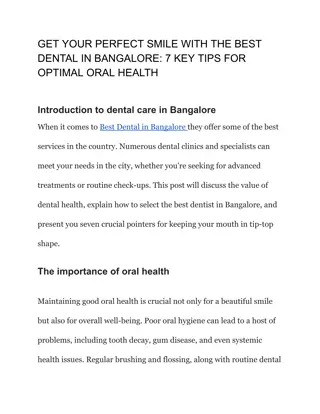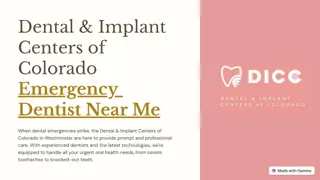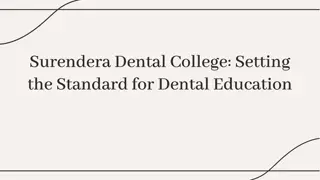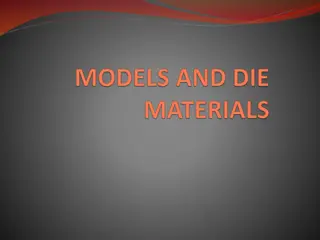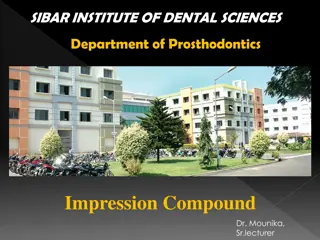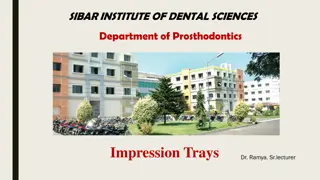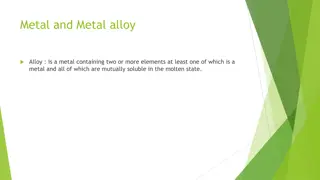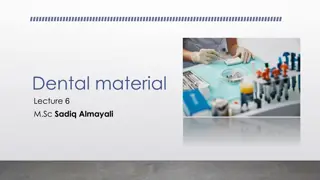Understanding Dental Impression Materials and Techniques
Dental impression materials are essential in dentistry to create precise negative records of the oral tissues. The process involves obtaining a negative impression and then producing a positive reproduction using materials like dental stone. These materials must meet specific desirable properties to ensure accuracy, safety, and ease of use. Impressions can be classified into rigid and elastic materials based on their set material properties. Examples include impression plaster, hydrocolloids, and elastomers. Each material has unique characteristics suited for different patient scenarios.
Download Presentation

Please find below an Image/Link to download the presentation.
The content on the website is provided AS IS for your information and personal use only. It may not be sold, licensed, or shared on other websites without obtaining consent from the author. Download presentation by click this link. If you encounter any issues during the download, it is possible that the publisher has removed the file from their server.
E N D
Presentation Transcript
Dental Impression: It is a negative record of tissue of the mouth. It is used to reproduce the form of the teeth and surrounding tissues. *A positive reproduction is obtained by pouring dental stone or other suitable material into the impression and allowing it to harden.
**The positive reproduction of a single tooth is described as die, and when several teeth or a whole arch is reproduced, it is called cast or model.
***The impression material is carried to the mouth in a tray, which either stock tray or special tray.
Requirements (desirable properties) of impression materials: 1- Accurate reproduction of surface details. 2- A pleasant odor, taste, and esthetic color. 3- Absence of toxic or irritant constituents. 4- Adequate shelf life for requirements of storage and distribution. 5- Reasonable cost. 6- Easy to use with the minimum of equipment. 7- Setting characteristics that meet clinical requirements. 8- Satisfactory consistency and texture. 9- Readily wets oral tissues. 10- Elastic properties with freedom from permanent deformation after strain. 11- Adequate strength so it will not break or tear on removal from the mouth. 12- Dimensional stability over temperature and humidity ranges normally found in clinical and laboratory procedures for a period long enough to permit the production of a cast or die. 13- Compatibility with cast and die materials. 14- Readily disinfected without loss of accuracy. 15- No release of gas during the setting of the impression or cast and die materials.
CLASSIFICATIONS OF IMPRESSION MATERIALS According to the properties of set material (elasticity) According to the properties of set material (elasticity) 1- RIGID IMPRESSION MATERIALS They cannot engage undercuts, so their use is restricted to edentulous patient without undercut. a- Impression plaster. b- Impression compound. c- Zinc oxide eugenol. d- Impression wax. 2- ELASTIC IMPRESSION MATERIALS They can engage undercuts, and they may be used in edentulous, partially dentate, and fully dentate patients. Hydrocolloid: a- Reversible hydrocolloid (agar-agar). b- Irreversible hydrocolloid (alginate). Elastomers a- Polysulfide. b- Silicone: - Condensation polymerizing silicone. - Addition polymerizing silicone. c- Polyether.
Impression Plaster The chemical formula is (Ca SO 4 .1/2 H 2 O), this impression material is known to be very accurate with minimum setting expansion (<0.06%). The water/powder ratio is higher than that for dental plaster. This impression material contains additives that control and regulate both setting time and expansion (K 2 SO 4 ).
Impression Compound Impression compound is described as a rigid, reversible impression material which sets by physical changes. On applying heat, it softens and on cooling it hardens. They supplied as sheet, stick, and cake.
Types:- 1- Type I Impression Compound (Lower Fusing) *Sheet Form Material: it is softened using water bath, a temperature in range (55-60 c), knead the material after it has been heated in water to ensure its being at a uniform temperature. Storage in hot water should not be long that important constituents such as stearic acid may be leached out. Overheating make the compound sticky and difficult to handle. *Stick Form Material: it is softened over a flame. The compound should not be allowed to boil otherwise, the plasticizers are volatilized.
2- Type II Tray Compound (Higher Fusing) It is used to prepare a tray for making an impression. It is generally stiffer and has less flow than regular impression compound.
Zinc Oxide Eugenol Impression Material Classification 1- Type I (Hard). 2- Type II (Soft). Available as 1- base paste (white in color). 2- Accelerator or reactor or catalyst paste (red in color).
Factors Controlling the Setting Time a- particles size of zinc oxide powder: if the particle size is small, the setting time is less. b- By varying the lengths of the two pastes. c- By adding a dropping of water, the setting time can be decreased. d- Longer the mixing time, shorter is the setting time. e- High atmospheric temperature and humidity decrease the setting time. f- Cooling the mixing slab, spatula increase the setting time. g- By adding a dropping of oil or wax, the setting time can be increased.
Reversible hydrocolloid (agar-agar). This impression material is liquid state at elevated temperature that changes into viscoelastic state upon cooling. The material preparation requires special equipment as well as special water-cooled trays for impression making. Although it is an excellent impression material and yields accurate impressions, presently it has been largely replaced by alginate hydrocolloid and rubber impression materials.
Reversible hydrocolloid (Alginate impression material) Alginate was developed as a substitute for agar. Currently, alginate is more popular than agar for primary impression. Its good elastic property, its long term stability is quite poor. Hand mixing is required and the powder/water ratio can affect the setting reaction, strength and consistency.
Polysulfide Impression Material Polysulfide rubber impression material has a polysulfide polymer base that reacts with sulfur with help of a catalyst. This impression material has good elastic property and excellent tear strength. However, this impression material has unpleasant smell. It is available in different consistencies.
Silicone Impression Material a- Condensation - cured silicone: They consist of a base material and a catalyst. The base material is a dimethyl siloxane with 35- 70% silica filler, with the help of alkyl silicate catalyst the polymerization is carried out by liberation alcohol. The material has rapid setting reaction but high setting shrinkage.
b- Addition cured silicone: They are known as polysiloxanes, this impression material is also provided as a base and a catalyst tubes with no byproduct resulted upon reaction. This material has long term stability as well as being hydrophobic with excellent elastic properties.
Polyether Impression Material The base is a polyether with terminal imine rings that undergo cross-linkage by 2,5-dichlorobezene sulfonate. It has a rapid setting time, with moderate dimensional change on setting, good elastic recovery. It can induce allergic reaction.









